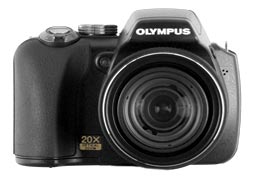To avoid publishing measurements which could be unfairly improved by noise reduction processing on RAW, we check every camera’s autocorrelation function for each ISO and on the whole sensor dynamic (for further information, see the dxomark Insight, “Half-Cooked Raw”)
The Olympus SP 565 UZ generates unprocessed images from ISO 60 to ISO 400, per Figure 1 below. The autocorrelation function shows a single peak, which denotes white noise only

Surprisingly, the autocorrelation function of the green channel at ISO 800 shows a wider base (Figure 2), which means noise reduction filtering. As explained in above-linked Insight, such filtering means that the measured Noise decreases, but details can be lost.

The SP 565 UZ’s noise processing explains the small gap between the Full SNR curves at ISO 400 and ISO 800.
The autocorrelation function at ISO 1600 shows a regular single peak, indicating that noise processing reduction is turned off.
As Low-light ISO is not impacted by measurements at ISO 800 (the quality thresholds are reached for ISOs smaller than ISO 400), this noise processing will not influence DxOMark scale results. We have therefore published all results, but use white points to flag the SP 565 UZ ‘s ISO 800 measurements. The white points mean that these measurements are influenced by noise reduction filtering and should not be taken into account when comparing with other sensors.
Disclaimer: This dxomark review evaluates only the selected camera’s RAW sensor performance metrics (i.e., Color Depth, Dynamic Range, and Low-Light ISO), and should not be construed as a review of the camera’s overall performance, as it does not address such other important criteria as image signal processing, mechanical robustness, ease of use, flexibility, optics, value for money, etc. While RAW sensor performance is critically important, it is not the only factor that should be taken into consideration when choosing a digital camera.





DXOMARK encourages its readers to share comments on the articles. To read or post comments, Disqus cookies are required. Change your Cookies Preferences and read more about our Comment Policy.